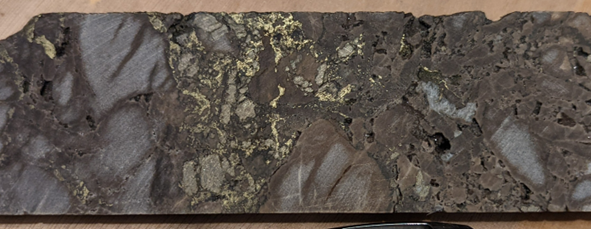RE:RE:RE:RE:RE:RE:RE:Assays schocor,...i read over on CEO, board,..a know it all over there, was hyping hole # 10 as 4 % cu,..
..The news showed no calcocite in hole 10 .. The cacocite is high grade copper and since there was no calcocite then the market new the reading of copper would below..."
..PS,.In my opinion,. the hype of 4 % copper was mentioned to discredit BAY "s news , because they new by geology what the results would be...seeing there was no Calcocite..
...Hole # 10,..caught the edge but still shows copper...Listen to video from Dr,. explain how the oxygen displaces the copper......Hole 10,..next June,..Highlights
- Initial results from drill hole ST22-10 have confirmed sediment hosted copper and zinc sulfide mineralization below the near-surface high-grade deposits at Storm
- The discovery drill hole is associated with a series of untested large and coincident geophysical anomalies identified across a zone that extends for more than 5 kilometres (km), indicating the potential for a large-scale sedimentary copper system at depth
- These results validate our geological model that interprets the extensive near-surface high-grade copper mineralization at Storm to be associated with a much larger sedimentary copper deposit at depth
- Early observations suggest the deeper copper system at Storm is analogous to Central African copper deposit styles
“We are excited the assay results from drill hole ST22-10 have confirmed the presence of sediment hosted type of copper and zinc mineralization at the Storm Project,” stated Thomas Ullrich, CEO of Aston Bay. “This style of mineralization, with its potential to host giant copper deposits such as those in Central Africa, has always been our target for discovery on Somerset Island.
“The visual logging shows the presence of sulfide minerals chalcopyrite, pyrite and sphalerite, which are extremely significant as it demonstrates movement of metal-bearing fluids through a thick permeable horizon. Elsewhere at Storm, including the nearby 4100N Zone, the chalcopyrite/pyrite/sphalerite mineralization occurs on the margin of much higher-grade chalcocite and bornite zone. This drill hole pierced the edge of a large conductive anomaly, so considerable discovery upside exists here and at the six other large anomalies that have yet to be tested.
“We now have two avenues for growth at the project: advancing the high-grade near-surface copper mineralization at Storm toward a maiden resource for a low cost, small footprint direct shipping product mining operation, and continued exploration for the potential discovery of a very large sediment hosted style of mineralization hidden in the subsurface.”
New Style of Copper and Zinc Sulfide Mineralization Confirmed
Drill hole ST22-10 intersected a thick sequence of sulfide mineralization hosted within carbonate sediments. The drill hole was targeting a large electromagnetic (EM) anomaly to the west, and deeper than the near-surface high-grade 4100N Zone.
Approximately 68.8 metres (m) of chalcopyrite, pyrite and sphalerite mineralization were intersected from 277m downhole in drill hole ST22-10 (approx. 230m vertical depth). The mineralization is interpreted to be stratabound and is hosted within a vuggy, bituminous and fossiliferous carbonate unit.
Visual observations of chalcopyrite and sphalerite in the drill core have now been confirmed by assays within the sampled intervals from ST22-10.
Of the sulfide mineralized zones, only portions containing clear and abundant chalcopyrite and sphalerite were sampled with the aim of confirming sediment hosted copper and zinc mineralization. Most of the pyrite-dominant zones were excluded from samples submitted for assay - see Table 1 for assay results and Figure 3 for a geological cross section of the drill hole. These results confirm the presence of sediment hosted copper and zinc sulfide mineralization and have verified the discovery of this new style of mineralization at Storm.
Geophysical properties logging of sections of the core will be conducted on ST22-10 to refine the geophysical targeting model for follow-up drilling.
ST22-10 is the deepest drill hole completed at the Storm Project this season and highlights the outstanding exploration potential of the project area. Compilation of historical induced polarization (IP), gravity and EM data reveals a series of large anomalies that sit below, and/or adjacent to the known near-surface high-grade copper mineralization and graben fault system.
The metal associations, zonation and geophysics suggest that the drill hole has intersected the edge of a new and significant mineralization system.

Figure 1: Chalcopyrite (copper sulfide) within ST22-10 drill core from 313m downhole.
Drill Hole ST22-10 Details
ST22-10 targeted the margin of a large (300m x 800m), previously untested EM anomaly. The hole was drilled to a downhole depth of 382.6m and intersected both a shallow zone and deep zone of visual copper and zinc mineralization.
The drill hole was terminated prematurely due to a mechanical failure, with the deeper mineralized zone still open at depth.
The shallow mineralized zone within ST22-10 consists of 34m of weak vein style, fracture hosted and minor blebby chalcocite over a number of intervals from 17m downhole. The assays also indicate the presence of sphalerite (zinc sulfide) up to 1.05% Zn in places, and minor galena (lead sulfide).
The deeper zone of mineralization is over 68m thick and remains open at depth. The mineralization consists of vug, open pore space and breccia filling as well as replacement style pyrite ± chalcopyrite ± sphalerite sulfide mineralization superimposed on pre-existing hydrocarbon rich sediments. This mineralization is interpreted to be of the sediment hosted style, and distinctly different than the fault zone breccia hosted copper mineralization intersected at the 2750N and 2200N Zones at Storm.
Assays up to 0.44% copper (Cu) confirm the presence of chalcopyrite within the lower mineralized sequence. Zinc mineralization has also been confirmed in the lower part of the sequence with sphalerite accompanied by pyrite and calcite within bituminous vugs.
Mineral Zonation